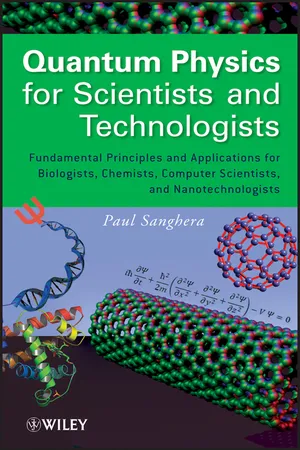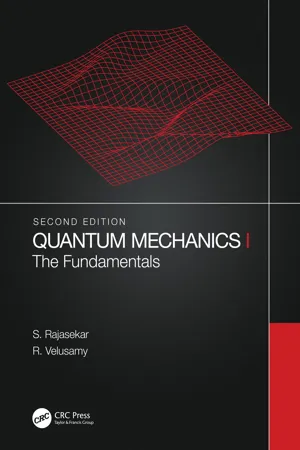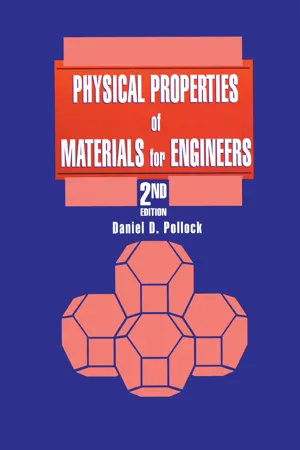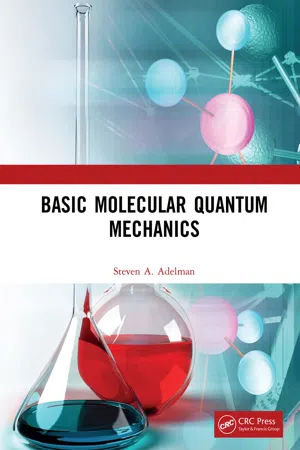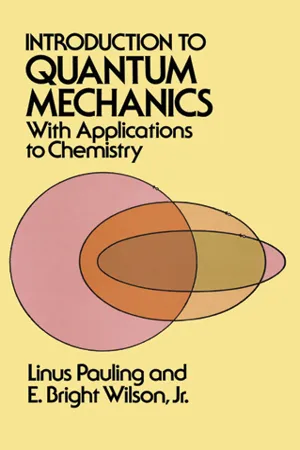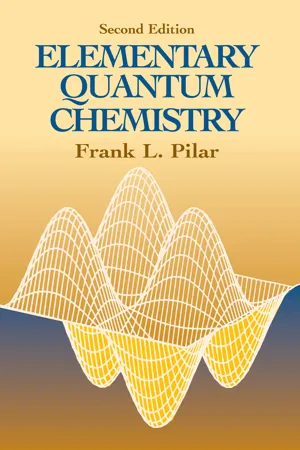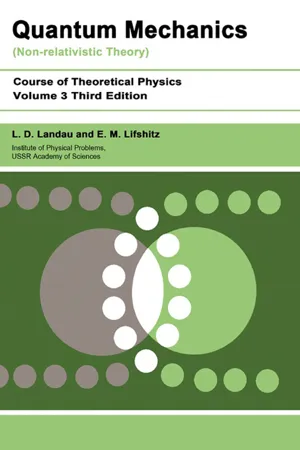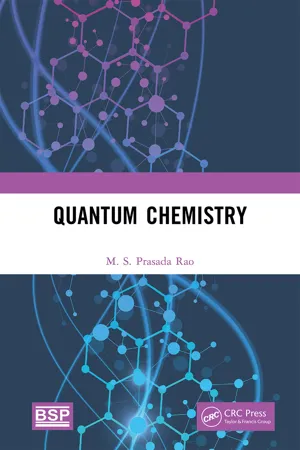Physics
Schodinger Equation Example
The Schrödinger equation is a fundamental equation in quantum mechanics that describes how the quantum state of a physical system changes over time. An example of its application is in determining the allowed energy levels of an electron in a hydrogen atom. By solving the Schrödinger equation for the hydrogen atom, one can obtain the wave functions and corresponding energy eigenvalues for the electron.
Written by Perlego with AI-assistance
Related key terms
Related key terms
1 of 4
Related key terms
1 of 3
12 Key excerpts on "Schodinger Equation Example"
- eBook - ePub
Quantum Physics for Scientists and Technologists
Fundamental Principles and Applications for Biologists, Chemists, Computer Scientists, and Nanotechnologists
- Paul Sanghera(Author)
- 2011(Publication Date)
- Wiley-Interscience(Publisher)
As described in Chapter 5, a theory bases itself on a minimum number of assumptions from which other empirical principles and laws can be derived that may have previously been proposed to explain the experimental results and observations. Equations, the means for efficiently encapsulating and describing the relationships among physical quantities and variables, are very powerful tools in many fields, especially in scientific disciplines, such as mathematics, physics, and chemistry. A good scientific theory is often expressed in terms of a few equations. For example, as you saw in Sections 1.15 and 1.16, the whole classical electromagnetic (EM) theory can be put into four equations, called Maxwell’s equations, and the whole of classical mechanics can be expressed in one equation, Newton’s second law of motion. Such is the case with quantum mechanics, which is often expressed through the Schrödinger equation introduced in Chapter 5.Just as seen in classical mechanics, Newton’s laws, especially the second law, governs the motion of objects in the macroscopic world; the Schrödinger equation governs the dynamics of particles and is used to derive the particle’s physical properties, such as location (position), momentum, and energy. This chapter will demonstrate the power of this equation by applying it to two general situations: a particle in a box and harmonic oscillators, which represent countless real-world applications. We will show how solving the Schrödinger equation for these situations naturally yields some of the principles that were previously postulated to explain experimental results, as discussed in Chapters 2–4. So, the main goal of this chapter is to understand and appreciate how the Schrödinger equation represents quantum mechanics. To that end, we will explore three avenues: introduction to the Schrödinger equation, solving this equation, and applying it to some simple systems, such as a particle in a box and a harmonic oscillator.6.2 THE SCHRÖDINGER WAVE EQUATIONThe Schrödinger wave equation holds the quantum mechanical description of the dynamics of a physical system. The story of the invention of this equation goes back to that graduate student Louis de Broglie, who proposed that there is a wave characteristic associated with each particle; just as there is a particle nature to light, which is discussed in Chapter 3. In November 1925, an Austrian physicist Erwin Schrödinger was presenting a seminar at the University of Zurich on the de Broglie’s model of particles behaving as waves. From among the audience, Peter Debye suggested that if there were a wave there ought to be a wave equation describing that wave’s behavior. Within a few weeks after the seminar, Schrödinger fused his knowledge of the quantum mechanical ideas and models existing at that time with what he knew about wave optics, resulting in his wave equation. Without going into the history of its evolution, here is the most general form of the Schrödinger wave equation expressed in Cartesian coordinates: - eBook - ePub
Quantum Mechanics I
The Fundamentals
- S. Rajasekar, R. Velusamy(Authors)
- 2022(Publication Date)
- CRC Press(Publisher)
2 Schrödinger Equation and Wave FunctionDOI: 10.1201/9781003172178-22.1 Introduction
Till 1925 the idea of what the quantum theory would be was unknown. During 1925 three different but equivalent versions of quantum theory were proposed – Schrödinger proposed wave mechanics; Heisenberg developed matrix mechanics and Dirac-introduced operator theory. Considering the de Broglie's matter waves Erwin Schrödinger, an Austrian physicist, argued that if a particle like an electron behaves as a wave then the equation of wave motion could be successfully applied to it. He postulated a function varying in both space and time in a wave-like manner (hence called wave function and denoted it as ψ). This function is generally complex and assumed to contain information about a system. Schrödinger set up a linear and time-dependent wave-like equation, called Schrödinger wave equation, to describe the wave aspect of a particle taking account of de Broglie's relation for wavelength. Physically,| ψ ( X , t ), where| 2ψ ( X , t )is the solution of the Schrödinger equation, is interpreted as position probability density. That is,| ψ ( X , t )is the probability density of observing a particle at position X at time t. ψ does not give exact outcomes of observations but helps us to know all possible events and their probabilities. Further, the probability interpretation allows us to find the average or expected result of a set of measurements on a quantum system.| 2There are several interesting features of the wave function ψ. The probability interpretation of| ψimposes certain conditions on meaningful ψ. Further, the| 2| ψsatisfies a conservation law, an equation analogous to the continuity equation of flow in hydrodynamics. To set the total probability unity the ψ must satisfy the normalization condition| 2. Knowing ψ we can compute expectation values of variables such as position, momentum, etc. In quantum mechanics the experimentally measurable variables are no longer dynamical variables but they become operators. The outcomes of experiments are the eigenvalues of the operators of the observables. An interesting result is that the equations of the time evolution of expectation values of position and momentum operators (called Ehrenfest's theorem) obey the same equation of motion of these variables in classical mechanics. On the other hand, the equation for the phase of the ψψ∫|− ∞∞| 2d τ = 1 - eBook - ePub
- Daniel D. Pollock(Author)
- 2020(Publication Date)
- CRC Press(Publisher)
CHAPTER 3The Schrödinger Wave Equation
3.1 INTRODUCTION
The approach here is to start with some of the elementary ideas of classical mechanics and to translate these concepts to their equivalents in quantum mechanics. This will be done by changing the classical components of the total energy of particle into their quantum mechanical equivalents and arriving at the Schrödinger equation. The solutions to this equation provide expressions for Ψ that give the most probable properties, as described in Section 2.8 , and result in naturally discrete energy values for the particles being considered.The solutions to the Schrödinger equation thus obtained are applied to describe the behaviors of electrons and ions. More complex applications of Schrödinger’s equation are outlined for the hydrogen and helium atoms. These show the basis for the Pauli exclusion principle and explain why the quantum numbers that are the same as those obtained for the hydrogen atom can be employed for atoms with many more electrons. Such solutions are used to describe the electron configurations of atoms, and in subsequent chapters, to develop the fundamental ideas of the modem theories of solids. The results relating to ions are used primarily to describe their contributions to the thermal properties of solids.3.2 CLASSICAL MECHANICS
A brief review of some of the classical ideas is presented as an introduction to quantum mechanics. Consider a mechanical system in which a particle of mass, m, is acted upon by a force. For simplicity the force will be considered to act in the x direction. The force acting on the particle, then, is given by F(x). This force function is defined asF( x )= −d dxV( x )(3-1) where V(x) is a potential function.The following Newtonian relationships are given, on this basis, as a review. The familiar relationship between force, F, mass, m, and acceleration, a, is given by - eBook - ePub
Quantum Mechanics
Non-Relativistic and Relativistic Theory
- Lukong Cornelius Fai(Author)
- 2022(Publication Date)
- CRC Press(Publisher)
2 Schrödinger EquationDOI: 10.1201/9781003273073-32.1 Stationary States
In the previous chapter, we did not examine the change of a state with time t . It has been assumed that we have been examining a state at a given moment t . In the general case, the state of a system changes with time t . For example, say the motion of an electron in a potential field, its wave function depends on time t :Considering the postulates of quantum mechanics, we evaluate the form of the differential equation and we use:Ψ = Ψ. Such a dependence has to be described by a differential equation in which we may haveq , t.,∂ Ψ∂ t, ⋯∂ 2Ψ∂t 2- Principle of reason. It may be formulated: The wave function of a system completely describes its properties including its properties at a given moment t as the properties during the evolution of the system with time.If we are given the initial stateΨat the initial momentq ,t 0t 0, then the stateΨof the system at the moment t should be defined univalently. The equation that we sort for should have such a structure such that from it, it should be possible to find univalently the stateq , tΨ. This follows that it should contain the derivative over time to the first order. From the principle of reason, the wave function or state function of a system evolves in time t according to the time-dependent Schrödinger equation that is the first-order differential equation with respect to time t :q , ti ℏ(2.1)=∂ Ψ∂ tΗ ^ΨwhereΗ ^is an operator acting on the wave function Ψ , and in order to find it, we should note that Equation 2.1 should be linear, considering:
- Principle of superposition: If Ψ is the solution of Equation 2.1, thenC Ψis also a solution andC = c o n s t. It follows that the linear operatorΗ ^
- eBook - ePub
- Steven A. Adelman(Author)
- 2021(Publication Date)
- CRC Press(Publisher)
3 The Schrodinger Equation and the Particle-in-a-BoxIn Chapters 4 –6 , we lay out the full formal basis of quantum mechanics, and in the succeeding chapters, we describe increasingly advanced applications of this basis. However, in order to convey some feeling for quantum mechanics before developing its full formal machinery in this chapter, we introduce the most useful quantum equation, the time-independent Schrodinger equation, and then apply it to one of the simplest quantum systems, the instructive one-dimensional particle-in-a-box system.The time-independent Schrodinger equation, as we will show in Section 3.2 , may be derived from the more fundamental time-dependent Schrodinger equation, already touched on in Section 1.5 . So we begin with the time-dependent Schrodinger equation. This equation cannot be derived from anything more fundamental. Rather, like Newton’s equation of motion, it is best viewed as a postulate that is accepted because it successfully predicts a vast range of phenomena.While the time-dependent Schrodinger equation cannot be derived, several non-rigorous plausibility arguments for its form exist. We next give one of these.3.1 A Heuristic “Derivation” of the Time-Dependent Schrodinger Equation
In our discussion of the photoelectric effect in Section 1.1 , we noted that Einstein discovered that light exhibits a wave–particle duality, namely that a light wave of frequency υ or wavelengthλ =where c is the speed of light, could also be viewed as a stream of particles called photons each with an energy E and momentumc υ,p .Einstein postulated that the particle properties of light E and p were related to its wave properties υ and λ as follows:E = h υ a n d p =(3.1)h λ.We further noted in Section 1.4 that de Broglie later hypothesized that ordinary particles also exhibit a wave–particle duality. Namely, de Broglie hypothesized that associated with a particle is a wave with de Broglie wavelengthλ .In analogy to Einstein’s photon relationp =, de Broglie postulated that the wavelength of the matter wave associated with a particle of momentum ph λ - Linus Pauling, E. Bright Wilson, E. Bright Wilson(Authors)
- 2012(Publication Date)
- Dover Publications(Publisher)
Chap. XV ), but for nearly all purposes the wave equation is a convenient and sufficient starting point.9a. The Wave Equation Including the Time. —Let us first consider a Newtonian system with one degree of freedom, consisting of a particle of mass m restricted to motion along a fixed straight line, which we take as the x axis, and let us assume that the system is further described by a potential-energy function V (x ) throughout the region – ∞ < × < + ∞. For this system the Schrödinger wave equation is assumed to beIn this equation the function Ψ(x , t ) is called the Schrödinger wave function including the time , or the probability amplitude function. It will be noticed that the equation is somewhat similar in form to the wave equations occurring in other branches of theoretical physics, as in the discussion of the motion of a vibrating string. The student facile in mathematical physics may well profit from investigating this similarity and also the analogy between classical mechanics and geometrical optics on the one hand, and wave mechanics and undulatory optics on the other.1 However, it is not necessary to do this. An extensive previous knowledge of partial differential equations and their usual applications in mathematical physics is not a necessary prerequisite for the study of wave mechanics, and indeed the study of wave mechanics may provide a satisfactory introduction to the subject for the more physically minded or chemically minded student.The Schrödinger time equation is closely related to the equation of classical Newtonian mechanicswhich states that the total energy W is equal to the sum of the kinetic energy T and the potential energy V and hence to the Hamiltonian function H (px, x ). Introducing the coordinate x and momentumpx- eBook - ePub
- Frank L. Pilar(Author)
- 2013(Publication Date)
- Dover Publications(Publisher)
Fig. 2-1 .Restricting our treatment to one dimension for the present, the classical wave equation iswhere Ψ = Ψ(x, t), the amplitude in classical theory, remains undefined in the present context. A solution to this equation which is general enough to include the interference characteristics of waves iswhere C is a constant, and a is the phase, given byFIGURE 2-1 The Schrödinger equation as an extension of de Broglie’s analogy between optics and mechanics.Let us now seek another differential equation having solutions of the form in Eq. (2-2) but with the additional requirement that this equation reflect the two most important quantum relationships hitherto known, namely, wave-particle duality and the quantization of radiation. Using de Broglie’s relationship Eq. (1-32) for λ and the Planck-Bohr quantum relationship for ν, the phase becomesDifferentiating Ψ once with respect to t, one obtainsThis may be rearranged toNext, we try to replace E with an expression containing the derivative of Ψ with respect to x. Differentiating Ψ once with respect to x leads towhich may be rearranged toThe latter equation may be interpreted as an operator equation in which the x component of the linear momentum is represented by the differential operator ( /i)∂/∂x (see App. 4 for a discussion of operator algebra). For a system of mass m with a conservative potential V(x - eBook - ePub
- Mark Julian Everitt, Kieran Niels Bjergstrom, Stephen Neil Alexander Duffus(Authors)
- 2023(Publication Date)
- Wiley(Publisher)
key outcome that this introduction to quantum mechanics tries to make clear (although, as we shall see, this is not without its difficulties).Next, we use an examination of the energy of the system that arises from deriving the time-independent Schrödinger equation, to motivate a discussion of what it means to make a measurement in quantum mechanics. We discuss this in comparison to the classical analogy of measurement in statistical physics. The measurement process is the third key outcome of this introduction.Up until this point, a lot of the mathematical presentation may have appeared rather abstract. At some point we need to solve problems and make predictions. So we now give some specific examples of quantum states in terms of position, spin, and position and spin. The derivations here are long, but have been chosen as they make clear how few assumptions are needed to go from an abstract theory to some equations we can solve. We do not advise you try to remember all these long derivations – the key point is to understand how the few assumptions made at the beginning lead to the destination reached at the end of each section (such as the form of wave-function and the Schrödinger equation in position representation).We will close this chapter by presenting (i) a technical summary of what we have done, and (ii) a number of possible axiomatic foundations of quantum mechanics. These are important, as they are the theory.3.2 Motivating the Schrödinger Equation
Prerequisite Material: Section 1.2 : Generalising Vectors, Section 1.2.1 : Vector Spaces, Section 1.2.2 : Inner Product Section 1.2.3 : Dirac NotationIn developing a new theory, we do not want to abandon the best parts of an old theory. In the following discussion, we try to emphasise how much of classical physics is in fact retained in quantum physics, which is far less of a revolutionary theory than many people think. Note that arguments, such as the one that follows, are always speculative and based on having to reject some ideas thought evidently correct, and replace those with new ones that might look odd. - eBook - ePub
- Robert Weinstock(Author)
- 2012(Publication Date)
- Dover Publications(Publisher)
d ) below, is applied to the approximate solution of certain atomic problems.(Discussion of the constant K which appears in the Schrödinger equation is reserved for 11-2(d ) below.)11-2. The Wave Character of a Particle. Second Derivation of the Schrödinger EquationPrior to the discovery of the Schrödinger equation, De Broglie had developed an approach to the theoretical study of the atom which is based upon what he considered a fictitious wave character associated with a material particle. The theory was presented as a physically plausible basis for certain inherently arbitrary rules of procedure in the older (1913), narrowly successful, atomic theory of Bohr. Inasmuch as Schrodinger’s application of “his” equation to the hydrogen atom (11-3 below) yielded the same (experimentally verified) energy levels as the Bohr theory, he sought to develop a connection between his own work and the wave theory of De Broglie. He found the desired connection with the aid of Fermat’s principle (Chap. 5 ), the principle of least action (6-6), and the form of classical mechanics embodied in the Hamilton-Jacobi differential equation (6-5). The extreme importance of this connection achieved full recognition with the almost simultaneous establishment of the physical wave character of electrons through the experiments of Thomson, Davisson and Germer, and others.(a ) In order to develop the essence of the connection between the Schrödinger equation and the wave character of material particles we consider briefly a few aspects of the subject of wave phenomena in general. For our present purpose we may define a wave as a “disturbance” Ψ = Ψ (x , y , z , t )† which is propagated through space so as to be described by the equationwhere u - eBook - ePub
Quantum Mechanics
Non-Relativistic Theory
- L D Landau, E.M. Lifshitz(Authors)
- 1981(Publication Date)
- Butterworth-Heinemann(Publisher)
†(17.4)The first term can be regarded as the operator of the kinetic energy and the second as that of the potential energy. In particular, the Hamiltonian for a single particle in an external field is(17.5)where U (x, y, z ) is the potential energy of the particle in the external field.Substituting the expressions (17.2) to 17.5) in the general equation (8.1) , we obtain the wave equations for the corresponding systems. We shall write out here the wave equation for a particle in an external field:(17.6)The equation (10.2) , which determines the stationary states, takes the form(17.7)The equations (17.6) and (17.7) were obtained by Schrödinger in 1926 and are called Schrödinger’s equations .For a free particle, equation (17.7) has the form(17.8)This equation has solutions finite in all space for any positive value of the energy E . For states with definite directions of motion, these solutions are eigenfunctions of the momentum operator, with E = p 2 /2m . The complete (time-dependent) wave functions of such stationary states are(17.9)Each such function, a plane wave , describes a state in which the particle has a definite energy E and momentum p . The angular frequency of this wave is E/ħ and its wave vector k = p /ħ; the corresponding wavelength 2πħ/s is called the de Broglie wavelength of the particle.†The energy spectrum of a freely moving particle is thus found to be continuous, extending from zero to +∞. Each of these eigenvalues (except E = 0) is degenerate, and the degeneracy is infinite. For there corresponds to every value of E , different from zero, an infinite number of eigenfunctions (17.9) , differing in the direction of the vector p - eBook - ePub
- Lucjan Piela(Author)
- 2006(Publication Date)
- Elsevier Science(Publisher)
Fig. 1.8 .a, c.2.2.4 MATHEMATICAL AND PHYSICAL SOLUTIONS
It is worth noting that not all solutions of the Schrödinger equation are physically acceptable.For example, for bound states, all solutions other than those of class Q (see p. 895 ) must be rejected. In addition, these solutions ψ , which do not exhibit the proper symmetry, even if |ψ |2 does, have also to be rejected. They are called mathematical (non-physical) solutions to the Schrödinger equation. Sometimes such mathematical solutions correspond to a lower energy than any physically acceptable energy (known as underground states ). In particular, such illegal, non-acceptable functions are asymmetric with respect to the label exchange for electrons (e.g., symmetric for some pairs and antisymmetric for others). Also, a fully symmetric function would also be such a non-physical (purely mathematical) solution.underground states2.3 THE TIME-DEPENDENT SCHRÖDINGER EQUATION
What would happen if one prepared the system in a given state ψ , which does not represent a stationary state? For example, one may deform a molecule by using an electric field and then switch the field off.25 The molecule will suddenly turn out to be in state ψ , that is not its stationary state. Then, according to quantum mechanics, the state of the molecule will start to change according to the time evolution equation (time-dependent Schrödinger equation)(2.13)H ˆψ = i ℏ⋅∂ ψ∂ t(2.13)The equation plays a role analogous to Newton’s equation of motion in classical mechanics. The position and momentum of a particle change according to Newton’s equation. In the time-dependent Schrödinger equation the evolution proceeds in a completely different space − in the space of states or Hilbert space (cf. Appendix B , p. 895 ).Therefore, in quantum mechanics one has absolute determinism, but in the state space. Indeterminism begins only in our space, when one asks about the coordinates of a particle. - eBook - ePub
- M. S. Prasada Rao(Author)
- 2022(Publication Date)
- CRC Press(Publisher)
Chapter 4 Applications of Schrödinger Equation-1 (Simple systems with constant potential energy)4.1 Particle in a One-dimensional Box
As an application of the postulates of quantum mechanics, we now discuss a simple problem that of a particle constrained to move in a one dimensional box. This problem is an excellent one because it illustrates a number of quantum mechanical principles, and at the same time shows how discrete energy levels inevitably arise, whenever a small particle is confined to a region in space.For the sake of simplicity, a one-dimensional box will be considered. In three-dimensional box, the wave function is represented by ψxyz and in one-dimensional box by ψx . Since the particle is to be some sort of a realistic particle, such as an electron, our wave function must be a function that does things a real particle will do. Such a function is known as a well behaved function. This requires that it is everywhere continuous, smooth, finite, and single valued.Let a particle be placed in a one-dimensional box shown below.Particle in a one-dimensional boxTo solve a problem in wave mechanics, it is necessary to solve the wave equation for the particular problem at hand.For the case of one-dimensional system, the wave equation reduces to∇ 2ψ+x y z8π 2mh 2(E − V)ψ= 0x y zFor the case of one-dimensional system, the wave equation reduces to+d 2ψ xdx 28π 2mh 2(E − V)ψ x= 0+d 2ψ xdx 28π 2mh 2(E − V)ψ x= 0It was assumed that while the particle remained in the box, it had zero potential energy. Thus, as long as the particle remains in the box, its potential energy will be zero and the wave equation will reduce further to,
Index pages curate the most relevant extracts from our library of academic textbooks. They’ve been created using an in-house natural language model (NLM), each adding context and meaning to key research topics.
Explore more topic indexes
Explore more topic indexes
1 of 6
Explore more topic indexes
1 of 4
